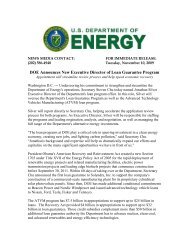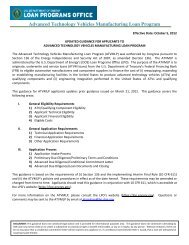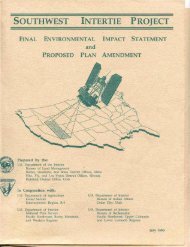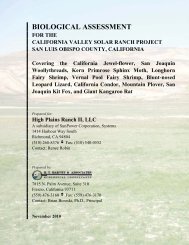Bureau of Land Management's Decision Record and Environmental
Bureau of Land Management's Decision Record and Environmental
Bureau of Land Management's Decision Record and Environmental
You also want an ePaper? Increase the reach of your titles
YUMPU automatically turns print PDFs into web optimized ePapers that Google loves.
Jersey Valley Geothermal Development Project<br />
<strong>Environmental</strong> Assessment: NV063-EAO8-091<br />
these activities would be “lost” until reclaimed. General human activity <strong>and</strong> generated noise<br />
could also keep some animals away from habitat not directly affected by surface disturbance.<br />
The amount <strong>of</strong> this direct <strong>and</strong> indirect surface disturbance expected from the cumulative projects<br />
is a small portion <strong>of</strong> the CESA. There is comparable wildlife habitat in the vicinity <strong>and</strong> region,<br />
<strong>and</strong> wildlife should be able to move away from small areas <strong>of</strong> direct disturbance <strong>and</strong> into<br />
adjacent suitable habitat. Reclamation <strong>of</strong> disturbed areas, as proposed by the Project, could<br />
reestablish habitat for wildlife.<br />
Threatened <strong>and</strong> Endangered Species<br />
As the proposed Project would have no effect on threatened <strong>and</strong> endangered species, there would<br />
be no cumulative impacts.<br />
Special Status Species<br />
The activities associated with the RFFAs would not be allowed in areas where there would be a<br />
negative impact on special status species. Implementation <strong>of</strong> mitigation measures, as identified<br />
for the proposed Project, could help to reduce the potential for adverse effects if also<br />
implemented for the other actions.<br />
Migratory Birds<br />
The amount <strong>of</strong> surface disturbance which may be created within the CESA by the RFFAs would<br />
be a very small portion <strong>of</strong> the CESA. Mitigation measure(s) requiring inventories for migratory<br />
bird nests <strong>and</strong> limiting ground disturbing activities, if conducted during the migratory bird<br />
nesting season, would help to reduce the potential adverse effects if also implemented for the<br />
other actions.<br />
4.4.5 Invasive, Nonnative Species<br />
Past <strong>and</strong> present actions may <strong>and</strong> have the potential to introduce <strong>and</strong> contribute to the spread <strong>of</strong><br />
noxious weeds, invasive <strong>and</strong> nonnative species (seed <strong>and</strong> vegetative plant parts) within the<br />
CESA, <strong>and</strong> the same may be expected from the RFFAs. Ongoing mineral exploration activities<br />
would cause the most extensive surface disturbance <strong>and</strong> would present the greatest opportunity<br />
for noxious weed, invasive <strong>and</strong> nonnative species introduction <strong>and</strong> proliferation. The number <strong>and</strong><br />
size <strong>of</strong> construction vehicles <strong>and</strong> construction activities could lend themselves to transporting<br />
noxious weeds, invasive <strong>and</strong> nonnative species (seed <strong>and</strong> vegetative plant parts) to areas where<br />
they had not previously existed.<br />
Mitigation measures include the inventory <strong>and</strong> treatment <strong>of</strong> newly disturbed areas <strong>and</strong> the<br />
washing <strong>of</strong> construction vehicles <strong>and</strong> workers’ boots to help reduce the potential effects.<br />
Additionally, impacts would be reduced when reclamation (reseeding/re-vegetation) activities<br />
commence.<br />
-88-







